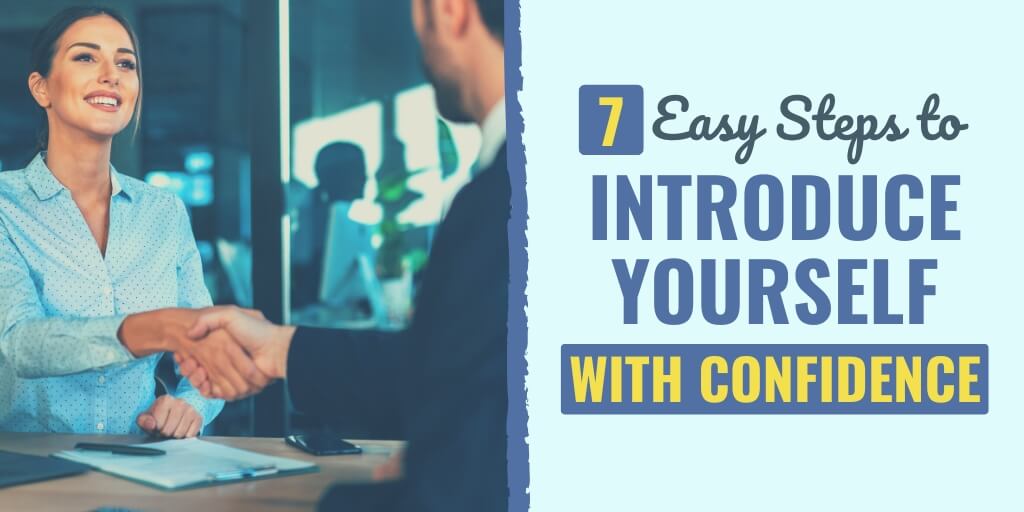There might be affiliate links on this page, which means we get a small commission of anything you buy. As an Amazon Associate we earn from qualifying purchases. Please do your own research before making any online purchase.
It only takes 1/10th of a second for us to form a judgment about someone we’ve met for the first time, and to form our first impression of them.
The first impression that a person gives to other people is the greatest factor in how that person is treated in everyday life. Make a good first impression and everything goes well.
Make a negative one, and it goes downhill from there. Unfortunately, it is much more difficult to win someone back after making a bad first impression than it is to turn someone off after making a good first impression.
This reality puts pressure on us every time we need to introduce ourselves to strangers.
Are we making a good impression? What if we say the wrong thing? Can they see how nervous we are? These thoughts often run through our heads when we are in social situations requiring self-introduction.
First Impressions Last
In this article, we’re providing you with the best tips on how to introduce yourself, so that you will be setting yourself up to make a good impression on your new acquaintances and potential business connections.
Although a good first impression isn’t a guaranteed ticket to a business partnership or for other people to like you, it is important because, as mentioned earlier, it has either a positive or negative impact on our daily lives.
Check out the video below, which explains the biology behind first impressions. It explores the source of people’s gut reactions and provides information about where our snap judgments come from.
Introducing Yourself – The Benefits of a Good Impression
So, what are the benefits of a good impression? What will you get out of putting forth the effort to come across a certain way to people that you don't know?
1. People find it easy to relate to you.
People have to be able to relate to you in order to want to develop a relationship with you of any kind. It is easiest to be around others who you feel like they understand you, and that you understand them.
We are social creatures by nature, from birth to death.
Relationships play a critical function in our lives, from the vital bonding and attachment period that newborns hold with their mothers to the need for the elderly to feel connected to other people in society.
The positive first impressions that people form about you make you personable, and allow people to feel a bond with you.
2. It allows you to build significant partnerships.
If you make a good first impression, the people you meet will be more likely to deem you as being trustworthy. They will usually be more willing to form relationships and business partnerships with you.
Alternatively, if you make a bad first impression, people will be quick to write you off, and you will not have that strong foundation on which a relationship needs to build.
It is important to be genuine the first time you meet someone so you show the best version of yourself. You don't want to be phony or over-the-top, because once the relationship begins to thrive, your new acquaintance will be able to tell that you were not being genuine.
3. It boosts your self-confidence.
It just so happens that some of the critical factors in making a good impression are also critical in having self-confidence. This is where your posture, eye contact, bright smile, and proper speech come into play.
Even the smallest change, such as straightening your posture and lifting your head up, can give other people—and you—the impression that you are a confident person.
Smiling will make you feel confident as well, and it will make other people around you feel more comfortable. Think about someone who is smiling and has good posture, and you'll be picturing someone with self-confidence.
With each successful interaction you have with others using this trick, you will sharpen your networking and people skills.
Self-confidence is the necessary skill for success, not only in sports but also in life. He then shares some tips on how to develop self-confidence.
Now let's look at some things to keep in mind when you are meeting someone for the first time and you need to introduce yourself.
Before we proceed, the truth is: Many people have problems with challenging themselves and pushing past their comfort zone. Watch the video below to learn about a 7-step process for getting out of your comfort zone:
Tips on How to Confidently Introduce Yourself
1. Dress for the occasion.
The biggest factor that affects others' first impressions of us is our physical appearance. It might sound tacky to judge others by how they look, but a visual impression is the first thing you will have access to.
Evaluating other people’s appearances is a survival trait that we inherited from our ancestors, who only had a split second to judge whether the creature they were encountering posed danger to them or not. In other words, it is a natural instinct to do this.
Take the extra steps to style your hair, give yourself a clean shave, and dress appropriately. Make sure your clothes fit you properly, that they don't have any holes in them, that the cotton is not pilling, and that your shoes are not worn down.
Doing so will allow you to feel better about yourself, and other people will be more likely to view you as a successful and confident person.
One tip to keep in mind after purchasing a new outfit is to practice wearing it at home before you wear it around other people so you can handle any potential wardrobe malfunctions before going out.
Showing others that you are able to put yourself together demonstrates to them that you have the competence to get the basics done well. At a minimum, it communicates to people that you care and are committed.
2. Create a more substantial introduction.
Rather than just saying your name during the initial introductions, try saying, “Great to meet you, (person’s name).”
This reinforces the recall of your new acquaintance’s name and is a good way to break the tension. It also puts the focus back on them, and people love to feel like they have earned the honor of being the center of your attention.
After you have created this connection with the other person, it is important to not let the conversation come to a screeching halt.
Notice something about them—their clothes, something they're holding, or if you have an indication of what the person does—and comment on it.
Ask a question that keeps the focus on the other person and makes you seem interested in what they have to say.
3. Smile in a sincere way.
You will exude positivity when you smile. Do it as naturally as possible.
Around 50% of the American population have chosen someone's smile as being the most memorable feature they recall when they meet someone for the first time. Greeting someone with a big smile displays confidence, joy, friendliness, warmth, and positivity.
A sincere smile starts with your mouth, but it engages your whole face. A genuine smile will pull your cheeks up and be evident through your eyes, which will communicate the emotions behind your smile.

Studies have even shown that people respond better to genuine smiles (which are measured by the appearance of laugh lines) than they respond to “polite” smiles.
It’s easy for others to assume that you are friendly, accepting, smart, and trustworthy when you lead with a sincere smile. Also, when you smile often, you will feel better about yourself, which will be evident to others.
4. Make eye contact with the person.
Imagine trying to hold a conversation with someone who is looking at everything going on around them except for you. It would make you feel pretty ignored, right?
Making eye contact is one way of showing that you respect the person you’ve just met and that you have an interest in what they are saying. If you are shy and have trouble maintaining eye contact, this is an important thing to practice.
Looking into someone's eyes can be intimidating, especially if it is a boss or someone who has some kind of authority over you. You can get more comfortable with this simply by practicing at home.
When you are watching television, every time a new person comes on the screen at a close range, notice the color of their eyes. This will get you into the habit of looking at people's eyes.
When you are having a first encounter in real life, also take note of their facial features or anything unique about them. This way you won't have to overthink giving direct eye contact, and you can become more comfortable with it.
Looking away too much makes you appear shifty or untrustworthy. If you cannot look someone in the eye when you are speaking to them, they may assume that you are not telling the truth.
It is especially important to make eye contact while you're listening to someone, and slightly less so when you are speaking. Aim to make direct eye contact for 40-60% of a conversation as a general rule.
5. Do your homework.
If you’re introducing yourself to a particular person or group for business or career purposes, research all you can about your potential friend, business partner, or employer. Make sure that you know about their mission and goals and the work they do on a daily basis to achieve their results.
People love it when you already know something about them without them having to share. It shows that you cared enough to take some time to focus on their work, which demonstrates competency and honesty by emphasizing your initiative.
Also, prepare some relevant talking points before you meet the person or group. This will reduce the number of awkward silences that you encounter during your conversation.
It will also help you look competent in their field of work—whether you are in that field or not. Perhaps research some of the company's challenges or recent achievements.

Doing your homework can also help you engage in active listening because you will be equipped with the necessary knowledge to ask insightful questions.
While you are concentrating on what the other person is saying, if you have some background knowledge already, it will help you expand on the conversation more naturally.
6. Be aware of your body language.
Use open and relaxed postures. A person you’ve just met might interpret your yawning, crossing your arms over your chest, and slouching to be a sign that you’re not really interested in what they are saying, or that you’re nervous.
Do a mental body check from time to time when you are talking to someone, making sure that your face is friendly and relaxed, and that you are standing up tall with your shoulders back.
To start off a relationship on the right foot, make sure to use positive non-verbal cues to demonstrate your interest.
One trick is to make sure that you show the insides of your palms to the other person regularly, which will subconsciously give them the feeling that they are accepted by you, and that what they are saying is resonating with you.
It is also important to remain cognizant of your tone of voice. Use an enthusiastic tone that varies and is not monotone. You can even lean slightly in towards the speaker to illustrate your interest in what they are saying.
The infographic below gives us a quick overview on some interesting facts about the factors contributing to how we form first impressions.
7. Practice, practice, practice.
Practice can help you gain confidence. Rehearse possible scenarios with a friend until you achieve that level of self-confidence in introducing yourself to others.
The more you practice, the more natural it will come to you, and the more opportunities you will have to gain experience with different situations that you may encounter.
The more positive experiences you have with introducing yourself, the easier it will get. If you practice enough, introducing yourself with confidence will become second nature when you meet new people.
Final Thoughts on How to Introduce Yourself
We’ve learned that when introducing ourselves to others, the people we just met will form either a positive or negative first impression about us.
This phenomenon can put us on edge. The impressions others have about us can be the basis for how we’re treated in life.
We hope that the tips we provided on how to introduce yourself can boost your confidence. As you use them, you may find that you receive positive impressions from all the people that you meet in your professional, social, and personal life.
Now, as we wrap things up, you might want to check out other articles that can help you at understanding and improving yourself:
- 33 Self-Awareness Activities for Adults and Students
- How to Be More Outgoing and Talkative in Social Situations
- 8 SMART Goals Examples for Building More Confidence


